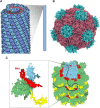Plant Virus Nanoparticles for Anti-cancer Therapy
- PMID: 34976959
- PMCID: PMC8714775
- DOI: 10.3389/fbioe.2021.642794
Plant Virus Nanoparticles for Anti-cancer Therapy
Abstract
Plant virus nanoparticles (VNPs) are inexpensive to produce, safe, biodegradable and efficacious as treatments. The applications of r plant virus nanoparticles range from epitope carriers for vaccines to agents in cancer immunotherapy. Both VNPs and virus-like particles (VLPs) are highly immunogenic and are readily phagocytosed by antigen presenting cells (APCs), which in turn elicit antigen processing and display of pathogenic epitopes on their surfaces. Since the VLPs are composed of multiple copies of their respective capsid proteins, they present repetitive multivalent scaffolds which aid in antigen presentation. Therefore, the VLPs prove to be highly suitable platforms for delivery and presentation of antigenic epitopes, resulting in induction of more robust immune response compared to those of their soluble counterparts. Since the tumor microenvironment poses the challenge of self-antigen tolerance, VLPs are preferrable platforms for delivery and display of self-antigens as well as otherwise weakly immunogenic antigens. These properties, in addition to their diminutive size, enable the VLPs to deliver vaccines to the draining lymph nodes in addition to promoting APC interactions. Furthermore, many plant viral VLPs possess inherent adjuvant properties dispensing with the requirement of additional adjuvants to stimulate immune activity. Some of the highly immunogenic VLPs elicit innate immune activity, which in turn instigate adaptive immunity in tumor micro-environments. Plant viral VLPs are nontoxic, inherently stable, and capable of being mass-produced as well as being modified with antigens and drugs, therefore providing an attractive option for eliciting anti-tumor immunity. The following review explores the use of plant viruses as epitope carrying nanoparticles and as a novel tools in cancer immunotherapy.
Keywords: cancer 2; imaging; nanoparticles; plant virus-like particles; therapeutics.
Copyright © 2021 Venkataraman, Apka, Shoeb, Badar and Hefferon.
Conflict of interest statement
The authors declare that the research was conducted in the absence of any commercial or financial relationships that could be construed as a potential conflict of interest.
Figures

Similar articles
-
A modular and self-adjuvanted multivalent vaccine platform based on porcine circovirus virus-like nanoparticles.J Nanobiotechnology. 2022 Nov 24;20(1):493. doi: 10.1186/s12951-022-01710-4. J Nanobiotechnology. 2022. PMID: 36424615 Free PMC article.
-
Recombinant helical plant virus-based nanoparticles for vaccination and immunotherapy.Virus Genes. 2018 Oct;54(5):623-637. doi: 10.1007/s11262-018-1583-y. Epub 2018 Jul 14. Virus Genes. 2018. PMID: 30008053 Review.
-
Frontiers in Bioengineering and Biotechnology: Plant Nanoparticles for Anti-Cancer Therapy.Vaccines (Basel). 2021 Jul 28;9(8):830. doi: 10.3390/vaccines9080830. Vaccines (Basel). 2021. PMID: 34451955 Free PMC article. Review.
-
Bacteriophage T4 nanoparticles for vaccine delivery against infectious diseases.Adv Drug Deliv Rev. 2019 May;145:57-72. doi: 10.1016/j.addr.2018.06.025. Epub 2018 Jul 6. Adv Drug Deliv Rev. 2019. PMID: 29981801 Free PMC article. Review.
-
Structure-based design and experimental engineering of a plant virus nanoparticle for the presentation of immunogenic epitopes and as a drug carrier.J Biomol Struct Dyn. 2014 Apr;32(4):630-47. doi: 10.1080/07391102.2013.785920. Epub 2013 May 15. J Biomol Struct Dyn. 2014. PMID: 23672348
Cited by
-
Engineering approaches for innate immune-mediated tumor microenvironment remodeling.Immunooncol Technol. 2023 Oct 6;21:100406. doi: 10.1016/j.iotech.2023.100406. eCollection 2024 Mar. Immunooncol Technol. 2023. PMID: 38213392 Free PMC article. Review.
-
A comprehensive review of using nanomaterials in cancer immunotherapy: Pros and Cons of clinical usage.3 Biotech. 2025 Jul;15(7):205. doi: 10.1007/s13205-025-04362-x. Epub 2025 Jun 9. 3 Biotech. 2025. PMID: 40502964 Review.
-
Applications of nanotechnologies for miRNA-based cancer therapeutics: current advances and future perspectives.Front Bioeng Biotechnol. 2023 Jul 27;11:1208547. doi: 10.3389/fbioe.2023.1208547. eCollection 2023. Front Bioeng Biotechnol. 2023. PMID: 37576994 Free PMC article. Review.
-
The biological roles of CD47 in ovarian cancer progression.Cancer Immunol Immunother. 2024 Jun 4;73(8):145. doi: 10.1007/s00262-024-03708-3. Cancer Immunol Immunother. 2024. PMID: 38832992 Free PMC article. Review.
-
The Use of Plant Viral Nanoparticles in Cancer Biotherapy-A Review.Viruses. 2025 Feb 1;17(2):218. doi: 10.3390/v17020218. Viruses. 2025. PMID: 40006973 Free PMC article. Review.
References
Publication types
LinkOut - more resources
Full Text Sources
Miscellaneous

